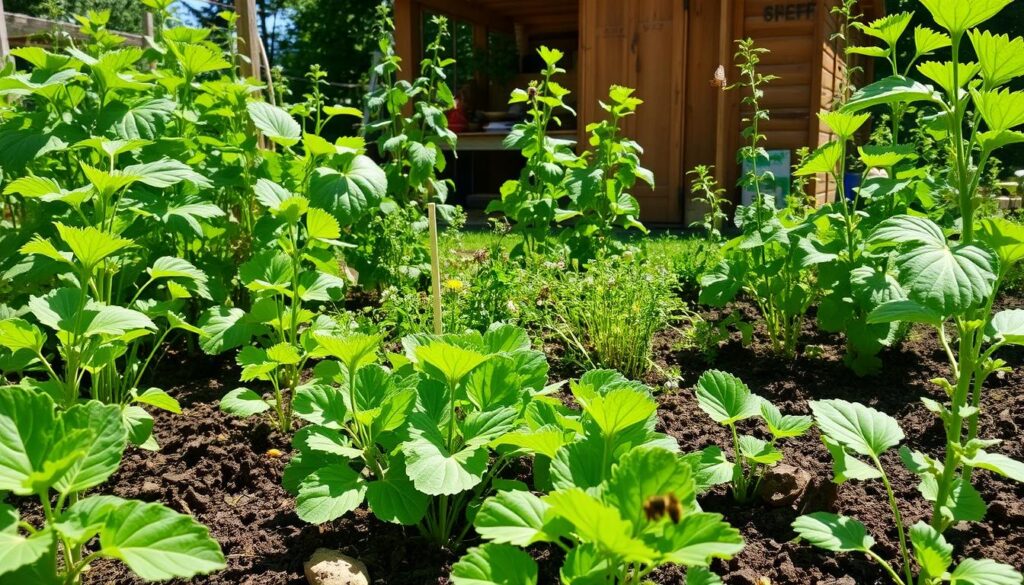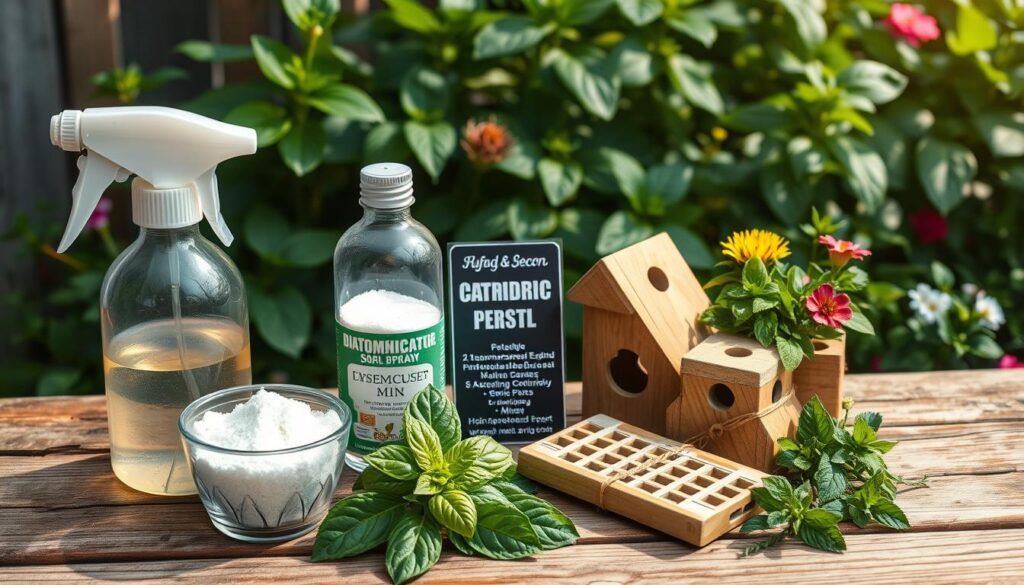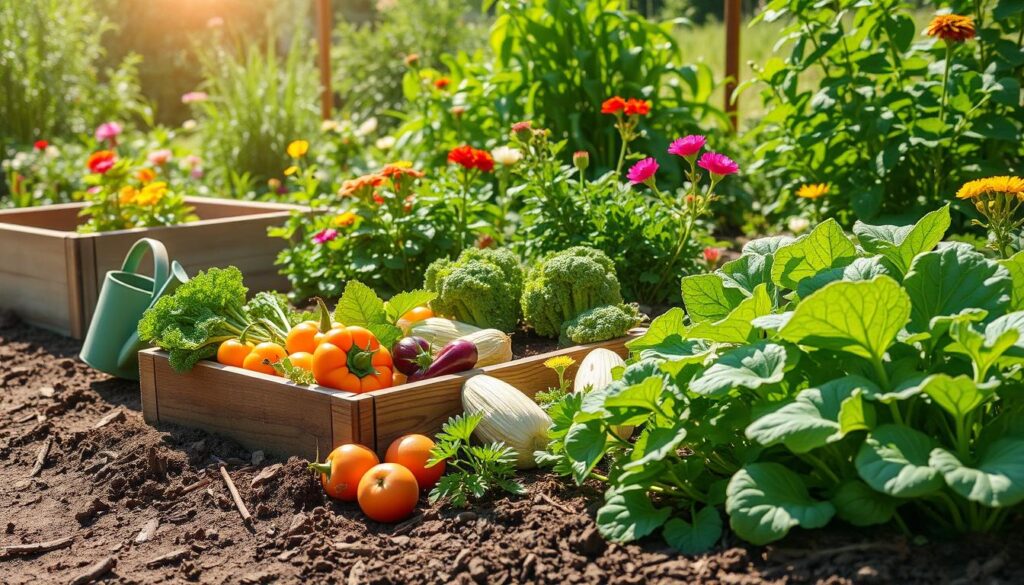Are you tired of the endless chemicals in store-bought produce? Imagine enjoying fresh, flavorful fruits and veggies from your own garden. This dream is closer than you think! In this guide, we’ll show you how to grow your own clean, natural food at home.
We’ll cover the health and environmental benefits of growing your own food. You’ll learn practical techniques to create a chemical-free oasis. Discover how to make a garden that’s good for you and the planet. Let’s start this exciting journey towards a healthier, more empowered life.
Key Takeaways
- Uncover the remarkable health advantages of pesticide-free foods
- Explore the environmental impact of natural growing methods
- Learn essential tools and equipment for successful organic gardening
- Unlock the secrets to preparing nutrient-rich soil for your plants
- Discover natural pest control strategies that actually work
Understanding the Impact of Chemical-Free Food Production
As we aim for a greener future, the role of non-toxic crops and chemical-free food production is crucial. This method benefits us and the planet in many ways.
Health Benefits of Pesticide-Free Foods
Eating pesticide-free foods boosts our health. It cuts down the risk of diseases like neurological disorders, hormone imbalances, and certain cancers. Our bodies work better without harmful chemicals, leading to better health and energy.
Environmental Advantages of Natural Growing Methods
Using eco-friendly cultivation methods protects our environment. It keeps natural ecosystems balanced, preserving biodiversity, soil health, and water quality. These natural growing methods help our planet stay healthy for future generations.
Cost Savings in the Long Run
Starting with chemical-free food production might cost more at first. But, it saves money in the long run. We avoid spending on harmful chemicals and enjoy better health and a cleaner environment. This makes pesticide-free gardening a smart choice.
Choosing eco-friendly cultivation and non-toxic crops is more than a trend. It’s a step towards a healthier, greener future. The benefits of this approach make it a clear choice for growing food without harmful chemicals.

Essential Tools and Equipment for Natural Gardening
To grow a healthy, chemical-free garden, you need the right tools. Let’s look at the key items for a lush, green garden without harmful chemicals.
First, a good set of hand tools is crucial. You’ll need sturdy trowels, hand forks, pruning shears, and hoes. These tools help you dig, weed, and shape plants easily.
- Trowel
- Hand fork
- Pruning shears
- Hoe
- Garden hose
- Watering can
New, eco-friendly tools are changing gardening. Think about getting a compost tumbler or bin. It turns waste into soil. A rain barrel also helps, saving rainwater for your plants.
| Tool | Purpose | Eco-Friendly Alternative |
|---|---|---|
| Sprayers | Applying natural pest control solutions | Eco-friendly pump sprayers |
| Tillers | Aerating and loosening soil | Broadforks and digging forks |
| Mulch spreaders | Distributing organic mulch evenly | Wheelbarrow and pitchfork |
With the right tools and green practices, we can make a natural garden. It will feed our plants and help the environment. Let’s start our pesticide-free gardening adventure!

Preparing Your Soil for Organic Growing Success
Starting an organic garden means taking care of the soil. In sustainable agriculture, the secret to great harvests is natural soil improvement. Let’s dive into the key steps to make your garden beds full of life and nutrients, all without chemicals.
Natural Soil Enhancement Techniques
Organic farming focuses on adding mineral-rich amendments to the soil. Things like crushed rock dust and bone meal help add nutrients and improve soil structure. Knowing your soil’s needs helps you create the perfect mix for your organic farming projects.
Composting Basics for Healthy Soil
Composting is a big win for sustainable agriculture. It turns kitchen scraps and yard waste into a nutrient-rich soil amendment. Learn how to compost right and watch your garden grow strong from the start.
Testing and Maintaining Soil pH
Soil pH is key for healthy plants. Regular soil tests help you adjust the acidity or alkalinity. Use lime, sulfur, or other natural products to keep your soil’s pH just right for organic gardening success.
| Soil pH Range | Ideal for Crops |
|---|---|
| 6.0 – 7.0 | Most vegetables, herbs, and flowers |
| 5.5 – 6.5 | Blueberries, potatoes, and azaleas |
| 7.0 – 8.0 | Asparagus, beets, and carrots |
Learning these basic soil preparation techniques will help you grow a chemical-free garden that flourishes year after year. Enjoy the fruits of your labor and savor the freshest, tastiest produce from your backyard.
Selecting the Right Plants for No Pesticides Growing
Starting a pesticide-free garden is all about picking the right plants. We’ll show you how to choose hardy, pest-resistant plants that grow well without chemicals. You’ll learn to grow a variety of chemical-free produce and non-toxic crops.
Some plants are natural winners against pests and diseases. These plants don’t need harmful sprays to stay healthy. By adding these plants to your garden, you’ll get a bountiful harvest and help the environment.
Pest-Resistant Plant Varieties
- Marigolds: These flowers add color and keep pests like aphids and nematodes away.
- Basil: Its scent keeps mosquitoes, flies, and aphids from your garden.
- Lavender: Its smell keeps moths, fleas, and mosquitoes out of your garden.
- Rosemary: This herb repels pests like cabbage moths, carrot flies, and bean beetles.
Adding these plants to your chemical-free produce garden makes it vibrant and self-sustaining. You’ll grow a lot without using harmful pesticides.
“A garden is a grand teacher. It teaches patience and careful watchfulness; it teaches industry and thrift; above all it teaches entire trust.” – Gertrude Jekyll
| Plant | Pest Resistance | Ideal Growing Conditions |
|---|---|---|
| Marigolds | Aphids, Nematodes | Full sun, well-drained soil |
| Basil | Mosquitoes, Flies, Aphids | Full sun, moist, well-drained soil |
| Lavender | Moths, Fleas, Mosquitoes | Full sun, dry, well-drained soil |
| Rosemary | Cabbage Moths, Carrot Flies, Bean Beetles | Full sun, dry, well-drained soil |
Natural Pest Control Methods That Actually Work
We’ve found many natural ways to keep pests away from your plants. These methods are good for your garden and the environment. No more harsh chemicals needed.
Companion Planting Strategies
Companion planting uses nature to fight pests. By placing plants wisely, we help beneficial insects and keep pests away. For example, marigolds can keep aphids off your veggies, and basil and tomatoes are great together.
Beneficial Insects in Your Garden
Our garden’s smallest creatures are its best defenders. Ladybugs, lacewings, and praying mantises eat pests. By welcoming these insects, we create a balanced garden ecosystem.
Homemade Organic Pest Deterrents
Make your own pest control with simple ingredients. Garlic, chili peppers, or neem oil can keep pests away. These homemade solutions are safe for your plants and the environment.
| Natural Pest Control Method | Targeted Pests | Key Benefits |
|---|---|---|
| Companion Planting | Aphids, Spider Mites, Whiteflies | Promotes Biodiversity, Discourages Pests Naturally |
| Beneficial Insects | Aphids, Caterpillars, Mealybugs | Biological Control, Maintains Ecological Balance |
| Homemade Organic Deterrents | Wide Range of Garden Pests | Customizable, Cost-Effective, Safe for the Environment |
Using these natural methods, we can grow a healthy, eco-friendly garden. No harsh chemicals needed. Welcome a vibrant, sustainable future for your plants.
Water Management in Chemical-Free Gardens
Sustainable agriculture and green growing practices are all about using water wisely. In our chemical-free gardens, we aim to use every drop of water. This way, our plants grow well without harmful pesticides or synthetic fertilizers. Let’s dive into the art of saving water and see how to grow a lush, healthy garden while caring for our natural resources.
Rainwater Harvesting: Nature’s Gift
Capturing and using rainwater is a rewarding way to water our gardens. Simple rainwater harvesting systems let us store this free, nutrient-rich water for our plants. This method cuts down on our use of municipal water and helps our groundwater and reduces stormwater runoff.
Efficient Irrigation Techniques
When watering our chemical-free gardens, less is more. We use drip irrigation and soaker hoses to water exactly where it’s needed. These methods cut down on evaporation and make sure our plants get the water they need, saving water in the process.
Mulching for Moisture Retention
Using organic mulch, like wood chips or shredded leaves, around our plants is a big help for water management. This simple trick keeps the soil moist, so we don’t have to water as often. It also stops too much water from evaporating. Our plants can grow well without needing chemical sprays or too much water.
| Water Management Strategies | Benefits |
|---|---|
| Rainwater Harvesting | Reduces reliance on municipal water, replenishes groundwater, and provides nutrient-rich water for plants. |
| Drip Irrigation and Soaker Hoses | Delivers water directly to the root zone, minimizing evaporation and water waste. |
| Organic Mulching | Retains soil moisture, reduces the frequency of watering, and prevents excessive evaporation. |
By using these water-saving practices, we can grow thriving, chemical-free gardens. These gardens not only give us fresh, natural food but also help our local environment. Let’s work together to create a future where saving water and sustainable agriculture are key.
Seasonal Planning for Sustainable Food Production
Embracing the natural cycles of the seasons is key to a thriving pesticide-free garden. By syncing with nature’s rhythm, we unlock abundant sustainable agriculture and eco-friendly cultivation all year. Let’s explore the essential steps for seasonal planning in your chemical-free oasis.
Spring Planning and Preparation
Spring brings renewal and rejuvenation to the garden. We’ll guide you through key tasks for a bountiful harvest. From amending soil with compost to planning crop rotation, you’re on your way to a thriving sustainable agriculture endeavor.
Summer Maintenance Techniques
Summer brings lush growth to the garden. We’ll share top eco-friendly cultivation tips to keep plants thriving. Learn how to water wisely and control pests naturally, keeping your garden vibrant through the heat.
Fall and Winter Considerations
Fall and winter don’t mark the end of gardening. They’re perfect for preparing your garden for the year ahead. We’ll show you how to protect soil, plant cover crops, and plan for the next growing season. This ensures a continuous cycle of sustainable agriculture.
“Synchronizing your garden with the natural rhythms of the seasons is the key to unlocking a bountiful, chemical-free harvest year after year.”
Harvesting and Storing Your Natural Produce
Congratulations! You’ve worked hard to grow pesticide-free food. Now, it’s time to enjoy the fruits of your labor. Harvesting at the right time ensures your food tastes great and is full of nutrients. But, don’t stop there. Proper storage is key to keeping your food fresh for longer.
Timing Your Pesticide-Free Harvest
Timing is everything when harvesting pesticide-free food. Each crop has its best time to pick. For example, pick leafy greens in the morning. Root vegetables like carrots and beets are ready when their tops turn yellow.
Storing Your Chemical-Free Produce
After you’ve picked your food, it’s important to keep it fresh. Here are some tips for storing your pesticide-free produce:
- Temperature Control: Fruits and veggies have different temperature needs. Leafy greens like the fridge, while tomatoes and avocados prefer room temperature.
- Moisture Management: Keeping the right moisture level is key. Use breathable containers or damp towels to keep your produce fresh without getting soggy.
- Ethylene Regulation: Some foods release ethylene gas, which can make others ripen too fast. Keep high-ethylene items like apples and bananas separate to keep your food fresh longer.
Learning how to harvest and store your pesticide-free food lets you enjoy it for months. Happy harvesting!
Common Challenges in No Pesticides Gardening
Embracing natural pest control and organic farming has its challenges. But don’t worry! We’ll give you the tools to face these issues head-on. Your garden will flourish without harmful chemicals.
Dealing with Pest Infestations Naturally
Pests can be a big problem for organic gardeners. Aphids and caterpillars can harm your plants. But, with smart strategies, you can keep pests away.
Try companion planting, attract beneficial insects, and make your own pest repellents. These methods help keep your garden healthy and pest-free.
Managing Plant Diseases Without Chemicals
Diseases can harm your plants in a pesticide-free garden. But, there are natural ways to fight them. Improve soil health and encourage biodiversity.
Use organic methods to resist diseases. This way, you can keep your garden healthy without synthetic chemicals.
Overcoming Growth Issues
Growing plants without pesticides can be tricky. Soil quality, water, and seasons affect growth. Learn to enhance soil and compost.
Understand pH testing too. These skills help you overcome growth challenges. Your plants will thrive and look great.
The natural gardening journey is full of learning and adaptation. With patience and a willingness to learn, you can beat common challenges. Create a chemical-free garden oasis in your backyard. Enjoy the journey to a sustainable, organic future.
Creating a Sustainable Garden Ecosystem
We know how vital it is to have a garden that’s good for the planet. By working with nature, we can turn our gardens into lively, connected spaces. These spaces support sustainable farming and help keep biodiversity strong.
To make a garden ecosystem thrive, we need to welcome many different plants and creatures. By choosing native plants, we draw in helpful bees and butterflies. We also get insects that eat pests, keeping our garden healthy.
- Incorporate a variety of flowering plants to attract a diverse range of pollinators
- Provide habitats for beneficial insects, such as ladybugs and lacewings, that prey on common garden pests
- Maintain a balance of different plant types, including annuals, perennials, and shrubs, to support a thriving ecosystem
Recycling garden waste is also key. Instead of throwing it away, we can compost it. This turns food scraps and leaves into soil that feeds our plants. It cuts down on the need for harmful chemicals.
A healthy, diverse garden ecosystem is the foundation for sustainable agriculture and environmental stewardship.
By gardening in an environmentally conscious way, we create a garden that’s good for us and the planet. It gives us fresh, chemical-free food and helps our local ecosystem stay strong. It’s a win for everyone.
Scaling Up: From Garden to Mini-Farm
Ready to grow your pesticide-free garden into a mini-farm? We’re here to help you expand your small garden into a thriving mini-farm. You’ll learn about smart space use, crop rotation, and using resources well.
Space Management Techniques
As your garden grows, managing space well is key. We’ll show you how to use every inch of land. This includes vertical gardening, intercropping, and more.
Learn to grow many different crops in a small space. This way, your mini-farm will be both productive and green.
Crop Rotation Strategies
A good crop rotation plan is vital for healthy soil. Our experts will teach you how to rotate crops. This keeps the soil rich and pests away.
By rotating crops, you help your organic farming system stay balanced. This is crucial for a healthy sustainable agriculture ecosystem.
Resource Optimization Methods
To run a successful mini-farm, you need to use resources wisely. We’ll teach you how to save water, energy, and labor. This keeps your farm efficient and profitable.
Discover how to use water-saving systems and renewable energy. This way, you can grow food naturally while being kind to the environment.
FAQ
What are the benefits of growing food without pesticides?
Growing food without pesticides is great for your health and the planet. It means you get clean, healthy food for your family. It also helps protect the environment and saves money over time.
What are the essential tools and equipment for natural gardening?
You’ll need basic tools like trowels and hoes for gardening without pesticides. Also, eco-friendly solutions like organic pest control and water-saving systems are key. The right tools help you grow a healthy, chemical-free garden.
How do I prepare my soil for organic growing success?
Healthy soil is crucial for a pesticide-free garden. Start by adding compost and using no-till methods. Test your soil’s pH to ensure it’s right for your plants. This way, you’ll create a rich environment for your plants to thrive.
How can I effectively control pests in my chemical-free garden?
Keeping your garden balanced is key to controlling pests naturally. Use companion planting and attract beneficial insects. Also, make your own organic pest control from natural ingredients. This way, you can fight pests without harmful chemicals.
How do I plan for a sustainable food production cycle in my pesticide-free garden?
Natural gardening needs a year-round plan. Start by preparing your garden in spring. Then, maintain it through summer. Consider fall and winter to keep your garden ready for the next season. This way, you can keep growing food sustainably.
What are some common challenges in pesticide-free gardening, and how can I overcome them?
Even experienced gardeners face challenges like pests and diseases. But, with the right knowledge, you can solve these problems naturally. We’ll share tips on controlling pests and diseases without chemicals.





